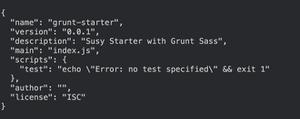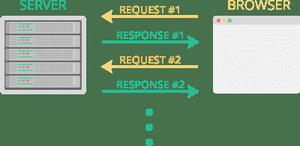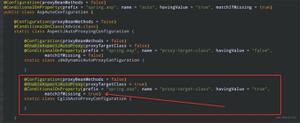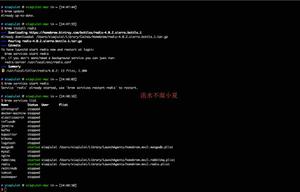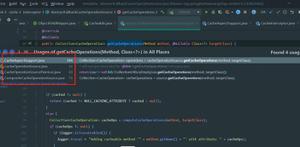Spring事务01TransactionInterceptor

DataSourceTransactionManager 类图,主要功能:获取事务对象、开启事务、提交事务、回滚事务
/** * Return a transaction object for the current transaction state.
* 返回当前事务状态的事务对象
*/
protected Object doGetTransaction();
/**
* Begin a new transaction with semantics according to the given transaction definition.
* 根据给定的事务定义使用语义开始一个新的事务
*/
protected void doBegin(Object transaction, TransactionDefinition definition);
/**
* Perform an actual commit of the given transaction.
* 执行给定事务的实际提交
*/
protected void doCommit(DefaultTransactionStatus status);
/**
* Perform an actual rollback of the given transaction.
* 执行给定事务的实际回滚
*/
protected void doRollback(DefaultTransactionStatus status);
TransactionInterceptor的类结构图,实现了 环绕通知 MethodInterceptor 接口
TransactionInterceptor 实现了 MethodInterceptor 接口,TransactionInterceptor 的 invoke() 方法:
@Override@Nullable
public Object invoke(MethodInvocation invocation) throws Throwable {
// Work out the target class: may be {@code null}.
// The TransactionAttributeSource should be passed the target class
// as well as the method, which may be from an interface.
Class<?> targetClass = (invocation.getThis() != null ? AopUtils.getTargetClass(invocation.getThis()) : null);
// Adapt to TransactionAspectSupport"s invokeWithinTransaction...
return invokeWithinTransaction(invocation.getMethod(), targetClass, invocation::proceed);
}
TransactionInterceptor类的invoke()方法会调用其父类TransactionAspectSupport中的invokeWithinTransaction()方法,方法实现如下:
/**
* General delegate for around-advice-based subclasses, delegating to several other template
* methods on this class. Able to handle {@link CallbackPreferringPlatformTransactionManager}
* as well as regular {@link PlatformTransactionManager} implementations.
* @param method the Method being invoked
* @param targetClass the target class that we"re invoking the method on
* @param invocation the callback to use for proceeding with the target invocation
* @return the return value of the method, if any
* @throws Throwable propagated from the target invocation
*/
@Nullable
protected Object invokeWithinTransaction(Method method, @Nullable Class<?> targetClass,
final InvocationCallback invocation) throws Throwable {
// If the transaction attribute is null, the method is non-transactional.
TransactionAttributeSource tas = getTransactionAttributeSource();
final TransactionAttribute txAttr = (tas != null ? tas.getTransactionAttribute(method, targetClass) : null);
final PlatformTransactionManager tm = determineTransactionManager(txAttr);
final String joinpointIdentification = methodIdentification(method, targetClass, txAttr);
if (txAttr == null || !(tm instanceof CallbackPreferringPlatformTransactionManager)) {
// Standard transaction demarcation with getTransaction and commit/rollback calls.
// 判断是否需要开启事务
TransactionInfo txInfo = createTransactionIfNecessary(tm, txAttr, joinpointIdentification);
Object retVal = null;
try {
// This is an around advice: Invoke the next interceptor in the chain.
// This will normally result in a target object being invoked.
// 执行回调,如果没有后续拦截器,就进入事务方法了
retVal = invocation.proceedWithInvocation();
}
catch (Throwable ex) {
// target invocation exception
// 事务发生异常
completeTransactionAfterThrowing(txInfo, ex);
throw ex;
}
finally {
cleanupTransactionInfo(txInfo);
}
// 事务未发生异常
commitTransactionAfterReturning(txInfo);
return retVal;
}
else {
final ThrowableHolder throwableHolder = new ThrowableHolder();
// It"s a CallbackPreferringPlatformTransactionManager: pass a TransactionCallback in.
try {
Object result = ((CallbackPreferringPlatformTransactionManager) tm).execute(txAttr, status -> {
TransactionInfo txInfo = prepareTransactionInfo(tm, txAttr, joinpointIdentification, status);
try {
return invocation.proceedWithInvocation();
}
catch (Throwable ex) {
if (txAttr.rollbackOn(ex)) {
// A RuntimeException: will lead to a rollback.
if (ex instanceof RuntimeException) {
throw (RuntimeException) ex;
}
else {
throw new ThrowableHolderException(ex);
}
}
else {
// A normal return value: will lead to a commit.
throwableHolder.throwable = ex;
return null;
}
}
finally {
cleanupTransactionInfo(txInfo);
}
});
// Check result state: It might indicate a Throwable to rethrow.
if (throwableHolder.throwable != null) {
throw throwableHolder.throwable;
}
return result;
}
catch (ThrowableHolderException ex) {
throw ex.getCause();
}
catch (TransactionSystemException ex2) {
if (throwableHolder.throwable != null) {
logger.error("Application exception overridden by commit exception", throwableHolder.throwable);
ex2.initApplicationException(throwableHolder.throwable);
}
throw ex2;
}
catch (Throwable ex2) {
if (throwableHolder.throwable != null) {
logger.error("Application exception overridden by commit exception", throwableHolder.throwable);
}
throw ex2;
}
}
}
重点分析createTransactionIfNecessary()方法,根据事务的传播属性做出不同的处理,核心是通过TransactionStatus来判断事务的属性。createTransactionIfNecessary()方法如下:
/** * Create a transaction if necessary based on the given TransactionAttribute.
* <p>Allows callers to perform custom TransactionAttribute lookups through
* the TransactionAttributeSource.
* @param txAttr the TransactionAttribute (may be {@code null})
* @param joinpointIdentification the fully qualified method name
* (used for monitoring and logging purposes)
* @return a TransactionInfo object, whether or not a transaction was created.
* The {@code hasTransaction()} method on TransactionInfo can be used to
* tell if there was a transaction created.
* @see #getTransactionAttributeSource()
*/
@SuppressWarnings("serial")
protected TransactionInfo createTransactionIfNecessary(@Nullable PlatformTransactionManager tm,
@Nullable TransactionAttribute txAttr, final String joinpointIdentification) {
// If no name specified, apply method identification as transaction name.
if (txAttr != null && txAttr.getName() == null) {
txAttr = new DelegatingTransactionAttribute(txAttr) {
@Override
public String getName() {
return joinpointIdentification;
}
};
}
TransactionStatus status = null;
if (txAttr != null) {
if (tm != null) {
status = tm.getTransaction(txAttr);
}
else {
if (logger.isDebugEnabled()) {
logger.debug("Skipping transactional joinpoint [" + joinpointIdentification +
"] because no transaction manager has been configured");
}
}
}
return prepareTransactionInfo(tm, txAttr, joinpointIdentification, status);
}
createTransactionIfNecessary()中会调用PlatformTransactionManager接口的getTransaction()方法,这里会调用PlatformTransactionManager接口的子类中的getTransaction()方法,接口的子类是AbstractPlatformTransactionManager,getTransaction()方法实现如下:
/** * This implementation handles propagation behavior. Delegates to
* {@code doGetTransaction}, {@code isExistingTransaction}
* and {@code doBegin}.
* @see #doGetTransaction
* @see #isExistingTransaction
* @see #doBegin
*/
@Override
public final TransactionStatus getTransaction(@Nullable TransactionDefinition definition) throws TransactionException {
// 调用 DataSourceTransactionManager.doGetTransaction()方法
// 将分析这个方法
Object transaction = doGetTransaction();
// Cache debug flag to avoid repeated checks.
boolean debugEnabled = logger.isDebugEnabled();
if (definition == null) {
// Use defaults if no transaction definition given.
definition = new DefaultTransactionDefinition();
}
// 是否已经存在一个 transaction
if (isExistingTransaction(transaction)) {
// Existing transaction found -> check propagation behavior to find out how to behave.
return handleExistingTransaction(definition, transaction, debugEnabled);
}
// Check definition settings for new transaction.
if (definition.getTimeout() < TransactionDefinition.TIMEOUT_DEFAULT) {
throw new InvalidTimeoutException("Invalid transaction timeout", definition.getTimeout());
}
// No existing transaction found -> check propagation behavior to find out how to proceed.
if (definition.getPropagationBehavior() == TransactionDefinition.PROPAGATION_MANDATORY) {
throw new IllegalTransactionStateException(
"No existing transaction found for transaction marked with propagation "mandatory"");
}
// 如果是:PROPAGATION_REQUIRED、PROPAGATION_REQUIRES_NEW、PROPAGATION_NESTED
// 这三种类型将开启一个新的事务
else if (definition.getPropagationBehavior() == TransactionDefinition.PROPAGATION_REQUIRED ||
definition.getPropagationBehavior() == TransactionDefinition.PROPAGATION_REQUIRES_NEW ||
definition.getPropagationBehavior() == TransactionDefinition.PROPAGATION_NESTED) {
SuspendedResourcesHolder suspendedResources = suspend(null);
if (debugEnabled) {
logger.debug("Creating new transaction with name [" + definition.getName() + "]: " + definition);
}
try {
boolean newSynchronization = (getTransactionSynchronization() != SYNCHRONIZATION_NEVER);
DefaultTransactionStatus status = newTransactionStatus(
definition, transaction, true, newSynchronization, debugEnabled, suspendedResources);
// 开始新事务,将分析这个方法
doBegin(transaction, definition);
prepareSynchronization(status, definition);
return status;
}
catch (RuntimeException | Error ex) {
resume(null, suspendedResources);
throw ex;
}
}
else {
// Create "empty" transaction: no actual transaction, but potentially synchronization.
if (definition.getIsolationLevel() != TransactionDefinition.ISOLATION_DEFAULT && logger.isWarnEnabled()) {
logger.warn("Custom isolation level specified but no actual transaction initiated; " +
"isolation level will effectively be ignored: " + definition);
}
boolean newSynchronization = (getTransactionSynchronization() == SYNCHRONIZATION_ALWAYS);
return prepareTransactionStatus(definition, null, true, newSynchronization, debugEnabled, null);
}
}
getTransaction()方法会调用子类DataSourceTransactionManager中的doGetTransaction()方法,doGetTransaction()方法代码如下:
/** * Return a transaction object for the current transaction state.
* <p>The returned object will usually be specific to the concrete transaction
* manager implementation, carrying corresponding transaction state in a
* modifiable fashion. This object will be passed into the other template
* methods (e.g. doBegin and doCommit), either directly or as part of a
* DefaultTransactionStatus instance.
* <p>The returned object should contain information about any existing
* transaction, that is, a transaction that has already started before the
* current {@code getTransaction} call on the transaction manager.
* Consequently, a {@code doGetTransaction} implementation will usually
* look for an existing transaction and store corresponding state in the
* returned transaction object.
* @return the current transaction object
* @throws org.springframework.transaction.CannotCreateTransactionException
* if transaction support is not available
* @throws TransactionException in case of lookup or system errors
* @see #doBegin
* @see #doCommit
* @see #doRollback
* @see DefaultTransactionStatus#getTransaction
*/
@Override
protected Object doGetTransaction() {
DataSourceTransactionObject txObject = new DataSourceTransactionObject();
txObject.setSavepointAllowed(isNestedTransactionAllowed());
ConnectionHolder conHolder =
(ConnectionHolder) TransactionSynchronizationManager.getResource(obtainDataSource());
txObject.setConnectionHolder(conHolder, false);
return txObject;
}
doGetTransaction()方法根据DataSource数据源获取DataSourceTransactionObject对象。接下来分析doBegin()方法,doBegin()方法的实现在DataSourceTransactionManager中,doBegin()方法如下:
/**
* Begin a new transaction with semantics according to the given transaction
* definition. Does not have to care about applying the propagation behavior,
* as this has already been handled by this abstract manager.
* <p>This method gets called when the transaction manager has decided to actually
* start a new transaction. Either there wasn"t any transaction before, or the
* previous transaction has been suspended.
* <p>A special scenario is a nested transaction without savepoint: If
* {@code useSavepointForNestedTransaction()} returns "false", this method
* will be called to start a nested transaction when necessary. In such a context,
* there will be an active transaction: The implementation of this method has
* to detect this and start an appropriate nested transaction.
* @param transaction transaction object returned by {@code doGetTransaction}
* @param definition a TransactionDefinition instance, describing propagation
* behavior, isolation level, read-only flag, timeout, and transaction name
* @throws TransactionException in case of creation or system errors
*/
/**
* This implementation sets the isolation level but ignores the timeout.
*/
@Override
protected void doBegin(Object transaction, TransactionDefinition definition) {
DataSourceTransactionObject txObject = (DataSourceTransactionObject) transaction;
Connection con = null;
try {
if (!txObject.hasConnectionHolder() ||
txObject.getConnectionHolder().isSynchronizedWithTransaction()) {
Connection newCon = obtainDataSource().getConnection();
if (logger.isDebugEnabled()) {
logger.debug("Acquired Connection [" + newCon + "] for JDBC transaction");
}
txObject.setConnectionHolder(new ConnectionHolder(newCon), true);
}
txObject.getConnectionHolder().setSynchronizedWithTransaction(true);
con = txObject.getConnectionHolder().getConnection();
Integer previousIsolationLevel = DataSourceUtils.prepareConnectionForTransaction(con, definition);
txObject.setPreviousIsolationLevel(previousIsolationLevel);
// Switch to manual commit if necessary. This is very expensive in some JDBC drivers,
// so we don"t want to do it unnecessarily (for example if we"ve explicitly
// configured the connection pool to set it already).
if (con.getAutoCommit()) {
txObject.setMustRestoreAutoCommit(true);
if (logger.isDebugEnabled()) {
logger.debug("Switching JDBC Connection [" + con + "] to manual commit");
}
// 开始事务,设置 autoCommit 为 false
con.setAutoCommit(false);
}
prepareTransactionalConnection(con, definition);
txObject.getConnectionHolder().setTransactionActive(true);
int timeout = determineTimeout(definition);
if (timeout != TransactionDefinition.TIMEOUT_DEFAULT) {
txObject.getConnectionHolder().setTimeoutInSeconds(timeout);
}
// Bind the connection holder to the thread.
// 这里将当前的 connection 放入 TransactionSynchronizationManager 中才会有
// 最终就是把 Connection 对象放入 ThreadLoacl 中
if (txObject.isNewConnectionHolder()) {
TransactionSynchronizationManager.bindResource(obtainDataSource(), txObject.getConnectionHolder());
}
}
catch (Throwable ex) {
if (txObject.isNewConnectionHolder()) {
DataSourceUtils.releaseConnection(con, obtainDataSource());
txObject.setConnectionHolder(null, false);
}
throw new CannotCreateTransactionException("Could not open JDBC Connection for transaction", ex);
}
}
在doGetTransaction()方法中,如果同一个线程再次进入执行,就会获取到同一个ConnectionHolder。
回到TransactionAspectSupport类的invokeWithinTransaction()方法,接下来将会调用InvocationCallback的proceedWithInvocation()方法,该方法的实现是调用了ReflectiveMethodInvocation类的proceed()方法,在3.6节的动态代理对象执行的部分已介绍过,此处不再赘述。
执行完代理对象的相关操作后,将会执行提交操作或者是回滚操作。
提交操作commitTransactionAfterReturning()方法如下:(在TransactionAspectSupport#invokeWithinTransaction()方法中)
/** * Execute after successful completion of call, but not after an exception was handled.
* Do nothing if we didn"t create a transaction.
* @param txInfo information about the current transaction
*/
protected void commitTransactionAfterReturning(@Nullable TransactionInfo txInfo) {
if (txInfo != null && txInfo.getTransactionStatus() != null) {
if (logger.isTraceEnabled()) {
logger.trace("Completing transaction for [" + txInfo.getJoinpointIdentification() + "]");
}
txInfo.getTransactionManager().commit(txInfo.getTransactionStatus());
}
}
commitTransactionAfterReturning()方法会调用AbstractPlatformTransactionManager类的commit()方法:
/** * This implementation of commit handles participating in existing
* transactions and programmatic rollback requests.
* Delegates to {@code isRollbackOnly}, {@code doCommit}
* and {@code rollback}.
* @see org.springframework.transaction.TransactionStatus#isRollbackOnly()
* @see #doCommit
* @see #rollback
*/
@Override
public final void commit(TransactionStatus status) throws TransactionException {
if (status.isCompleted()) {
throw new IllegalTransactionStateException(
"Transaction is already completed - do not call commit or rollback more than once per transaction");
}
DefaultTransactionStatus defStatus = (DefaultTransactionStatus) status;
if (defStatus.isLocalRollbackOnly()) {
if (defStatus.isDebug()) {
logger.debug("Transactional code has requested rollback");
}
processRollback(defStatus, false);
return;
}
if (!shouldCommitOnGlobalRollbackOnly() && defStatus.isGlobalRollbackOnly()) {
if (defStatus.isDebug()) {
logger.debug("Global transaction is marked as rollback-only but transactional code requested commit");
}
processRollback(defStatus, true);
return;
}
processCommit(defStatus);
}
commit()方法会调用processCommit()方法,最终将调用DataSourceTransactionManager()类的doCommit()方法,这里将会提交事务:
@Overrideprotected void doCommit(DefaultTransactionStatus status) {
DataSourceTransactionObject txObject = (DataSourceTransactionObject) status.getTransaction();
Connection con = txObject.getConnectionHolder().getConnection();
if (status.isDebug()) {
logger.debug("Committing JDBC transaction on Connection [" + con + "]");
}
try {
con.commit();
}
catch (SQLException ex) {
throw new TransactionSystemException("Could not commit JDBC transaction", ex);
}
}
如果代理对象执行操作过程中出现了异常,回到TransactionAspectSupport#invokeWithinTransaction() ,将会执行completeTransactionAfterThrowing()方法执行回滚操作:
/** * Handle a throwable, completing the transaction.
* We may commit or roll back, depending on the configuration.
* @param txInfo information about the current transaction
* @param ex throwable encountered
*/
protected void completeTransactionAfterThrowing(@Nullable TransactionInfo txInfo, Throwable ex) {
if (txInfo != null && txInfo.getTransactionStatus() != null) {
if (logger.isTraceEnabled()) {
logger.trace("Completing transaction for [" + txInfo.getJoinpointIdentification() +
"] after exception: " + ex);
}
if (txInfo.transactionAttribute != null && txInfo.transactionAttribute.rollbackOn(ex)) {
try {
txInfo.getTransactionManager().rollback(txInfo.getTransactionStatus());
}
catch (TransactionSystemException ex2) {
logger.error("Application exception overridden by rollback exception", ex);
ex2.initApplicationException(ex);
throw ex2;
}
catch (RuntimeException | Error ex2) {
logger.error("Application exception overridden by rollback exception", ex);
throw ex2;
}
}
else {
// We don"t roll back on this exception.
// Will still roll back if TransactionStatus.isRollbackOnly() is true.
try {
txInfo.getTransactionManager().commit(txInfo.getTransactionStatus());
}
catch (TransactionSystemException ex2) {
logger.error("Application exception overridden by commit exception", ex);
ex2.initApplicationException(ex);
throw ex2;
}
catch (RuntimeException | Error ex2) {
logger.error("Application exception overridden by commit exception", ex);
throw ex2;
}
}
}
}
completeTransactionAfterThrowing()方法里,调用AbstractPlatformTransactionManager()类的rollback()方法,最终调用DataSourceTransactionManager的doRollback()方法,这里将会回滚事务:
@Overrideprotected void doRollback(DefaultTransactionStatus status) {
DataSourceTransactionObject txObject = (DataSourceTransactionObject) status.getTransaction();
Connection con = txObject.getConnectionHolder().getConnection();
if (status.isDebug()) {
logger.debug("Rolling back JDBC transaction on Connection [" + con + "]");
}
try {
con.rollback();
}
catch (SQLException ex) {
throw new TransactionSystemException("Could not roll back JDBC transaction", ex);
}
}
以上是 Spring事务01TransactionInterceptor 的全部内容, 来源链接: utcz.com/z/513293.html

